Performance of Microchannel Heat Sink Made of Silicon Material with the Two-Sided Wedge
Abstract
:1. Introduction
2. Microchannel Heat Sink Computational Model
2.1. Computational Domain
2.2. Conservation Equations
2.3. Thermo-Physical Properties of Heat Transfer Fluid and Microchannel Heat Sink
2.4. Computational Procedure and Boundary Conditions
2.5. Data Acquisition
2.6. Model Validation
3. Result and Discussion
3.1. Velocity Distribution
3.2. Pressure Drop Distribution
3.3. Temperature Distribution
3.4. Performance Analysis
4. Conclusions
- Reynolds number significantly affects the Nusselt number as well as the friction factor. The Nusselt number varies in the following ranges of 5.963–8.521, 5.986–8.550, 6.009–8.568, 6.040–8.609, and 6.078–8.644 at 3°, 6°, 9°, 12°, and 15°, respectively;
- The maximum enhancement in Nusselt number is found in the case of an angle of 15°, whereas minimum enactment in friction factor is found in the case of an angle of 3°;
- The wedge angle does not show a significant effect on the friction factor and pumping power. However, the Reynolds number shows a considerable effect on friction factor and pumping power;
- The values of THPP were found to be greater than unity in all cases. Additionally, maximum values were found in the case of a wedge angle of 15°;
- THPP varies from 1.005 to 1.0185, 1.010 to 1.024, 1.014 to 1.030, 1.021 to 1.037, and 1.027 to 1.045 at corresponding wedge angles of 3°, 6°, 9°, 12°, and 15°, respectively.
Author Contributions
Funding
Institutional Review Board Statement
Informed Consent Statement
Data Availability Statement
Conflicts of Interest
Abbreviations
| Nomenclature | |
| Ac | Conjugated area (i.e., the area of the solid-fluid interface) (m2) |
| Aq | Heated area (i.e., silicon base area) (m2) |
| Dh | Hydraulic diameter of the microchannel (m) |
| f | Friction factor |
| h | Heat transfer coefficient |
| H | Height of microchannel (m) |
| Nu | Nusselt number |
| p | Pressure (Pa) |
| q | Heat flux that applied to the bottom wall of the micro heat sink (W/m2) |
| Re | Reynolds number |
| Tc | Conjugated area average aemperature (K) |
| Tf | Mass-average temperature of the coolant in the microchannel (K) |
| u | Velocity (m/s) |
| W | Width of microchannel (m) |
| ∆p | Pressure drop |
| Greek letters | |
| μf | Dynamic viscosity (N.s/m2) |
| η | Thermo-hydraulic performance parameters (THPP) |
| ρf | Density (kg/m3) |
| Subscripts | |
| f | Fluid (coolant) |
| h | Hydraulic |
| s | Solid (silicon) or conventional |
References
- Wilson, J. Thermal Facts & Fairy Tales: Moist Air and Cooling; Electronics Cooling: Plymouth Meeting, PA, USA, 2014; p. 4. [Google Scholar]
- Rodgers, P. The Need for Electronics Thermal Design Practices to Embrace Sustainability; Electronics Cooling: Plymouth Meeting, PA, USA, 2014; p. 2. [Google Scholar]
- Bar-Cohen, A. Thermal Packaging From Problem Solver to Performance Multiplier; Electronics Cooling: Plymouth Meeting, PA, USA, 2013; p. 8. [Google Scholar]
- Tuckerman, D.; Pease, R. High-Performance Heat Sinking for VLSI. IEEE Electron Device Lett. 1981, 2, 126–129. [Google Scholar] [CrossRef]
- Alhattab, H.A.; Albaghdadi, M.A.; Hashim, R.S.; Ali, A.H. Design of Micro Heat Sink for Power Transistor by Using CFD. In Proceedings of the 2016 Al-Sadeq International Conference on Multidisciplinary in IT and Communication Science and Applications (AIC-MITCSA), Baghdad, Iraq, 9–10 May 2016; pp. 268–272. [Google Scholar]
- Qu, W.L.; Mala, G.M.; Li, D.Q. Pressure-driven water in trapezoidal silicon. Int. J. Heat Mass Transf. 1999, 43, 353–364. [Google Scholar]
- Qu, W.L.; Mala, G.M.; Li, D.Q. Heat transfer for water flow in trapezoidal silicon microchannels. Int. J. Heat Mass Transf. 2000, 43, 3925–3936. [Google Scholar] [CrossRef]
- Yu, D.; Warrington, R.; Barren, R.; Ameel, T. An experimental and theoretical investigation of fluid flow and heat transfer in microtubes. Proc. ASME/JSME Therm. Eng. Conf. 1995, 1, 523–530. [Google Scholar]
- Pfahler, J. Liquid transport in micron and submicron size channels. Ph.D. Thesis, University of Pennsylvania, Philadelphia, PA, USA, 1992. [Google Scholar]
- Steinke, M.E.; Kandlikar, S.G. Single-phase liquid friction factors in microchannels. Int. J. Therm. Sci. 2006, 45, 1073–1083. [Google Scholar] [CrossRef]
- Toh, K.; Chen, X.; Chai, J.C. Numerical computation of fluid flow and heat transfer in microchannels. Int. J. Heat Mass Transf. 2002, 45, 5133–5141. [Google Scholar] [CrossRef]
- Tiselj, I.; Hetsroni, G.; Mavko, B.; Mosyak, A.; Pogrebnyak, E.; Segal, Z. Effect of axial conduction on the heat transfer in microchannels. Int. J. Heat Mass Transfer. 2004, 47, 2551–2565. [Google Scholar] [CrossRef]
- Lee, P.-S.; Garimella, S.V.; Liu, D. Investigation of heat transfer in rectangular microchannels. Int. J. Heat Mass Transf. 2005, 48, 1688–1704. [Google Scholar] [CrossRef] [Green Version]
- Peng, X.; Peterson, G. Convective heat transfer and flow friction for water flow in microchannel structures. Int. J. Heat Mass Transf. 1996, 39, 2599–2608. [Google Scholar] [CrossRef]
- Peng, X.; Peterson, G. The effect of thermofluid and geometrical parameters on convection of liquids through rectangular microchannels. Int. J. Heat Mass Transf. 1995, 38, 755–758. [Google Scholar] [CrossRef]
- Wu, H.; Cheng, P. An experimental study of convective heat transfer in silicon microchannels with different surface conditions. Int. J. Heat Mass Transf. 2003, 46, 2547–2556. [Google Scholar] [CrossRef]
- Zheng, W.; Sun, J.; Ma, C.; Yu, Q.; Zhang, Y.; Niu, T. Numerical Study of Fluid Flow and Heat Transfer Characteristics in a Cone-Column Combined Heat Sink. Energies 2021, 14, 1605. [Google Scholar] [CrossRef]
- Rogie, B.; Markussen, W.B.; Walther, J.H.; Kærn, M.R. Numerical Investigation of Air-Side Heat Transfer and Pressure Drop Characteristics of a New Triangular Finned Microchannel Evaporator with Water Drainage Slits. Fluids 2019, 4, 205. [Google Scholar] [CrossRef] [Green Version]
- Duan, Z.; Ma, H.; He, B.; Su, L.; Zhang, X. Pressure Drop of Microchannel Plate Fin Heat Sinks. Micromachines 2019, 10, 80. [Google Scholar] [CrossRef] [PubMed] [Green Version]
- Rasangika, A.H.D.K.; Nasif, M.S.; Pao, W.; Al-Waked, R. Numerical Investigation of the Effect of Square and Sinusoidal Pressure Drop of Microchannel Plate Fin Heat Sinks Heat Transfer Enhancement. Appl. Sci. 2022, 12, 4911. [Google Scholar] [CrossRef]
- Kumar, S.R.; Singh, S. Numerical Analysis for Augmentation of Thermal Performance of Single-Phase Flow in Microchannel Heat Sink of Different Sizes with or without Micro-Inserts. Fluids 2022, 7, 149. [Google Scholar] [CrossRef]
- Chen, H.; Chen, C.; Zhou, Y.; Yang, C.; Song, G.; Hou, F.; Jiao, B.; Liu, R. Evaluation and Optimization of a Cross-Rib Micro-Channel Heat Sink. Micromachines 2022, 13, 132. [Google Scholar] [CrossRef]
- Piasecka, M.; Piasecki, A.; Dadas, N. Experimental Study and CFD Modeling of Fluid Flow and Heat Transfer Characteristics in a Mini-Channel Heat Sink Using Simcenter STAR-CCM+ Software. Energies 2022, 15, 536. [Google Scholar] [CrossRef]
- Wu, T.; Wang, L.; Tang, Y.; Yin, C.; Li, X. Flow and Heat Transfer Performances of Liquid Metal Based Microchannel Heat Sinks under High Temperature Conditions. Micromachines 2022, 13, 95. [Google Scholar] [CrossRef]
- Jia, Y.; Huang, J.; Wang, J.; Li, H. Heat Transfer and Fluid Flow Characteristics of Microchannel with Oval-Shaped Micro Pin Fins. Entropy 2021, 23, 1482. [Google Scholar] [CrossRef]
- Eneren, P.; Aksoy, Y.T.; Vetrano, M.R. Experiments on Single-Phase Nanofluid Heat Transfer Mechanisms in Microchannel Heat Sinks: A Review. Energies 2022, 15, 2525. [Google Scholar] [CrossRef]
- Al-Baghdadi, M.A.S. A CFD Analysis of Transport Phenomena and Electrochemical Reactions in a Tubular-shaped Ambient Air-breathing PEM Micro Fuel Cell. HKIE Trans. 2010, 17, 1–8. [Google Scholar] [CrossRef]
- Al-Baghdadi, M.A.S. A CFD study of hygro–thermal stresses distribution in PEM fuel cell during regular cell operation. Renew. Energy 2009, 34, 674–682. [Google Scholar] [CrossRef]
- Al-Baghdadi, M.A.S. Prediction of Deformation and Hygro-Thermal Stresses Distribution in Ambient Air-Breathing PEM Fuel Cells using Three-Dimensional CFD Model. Recent Pat. Mech. Eng. 2009, 2, 26–39. [Google Scholar] [CrossRef]
- Chai, L.; Xia, G.D.; Wang, H.S. Numerical study of laminar flow and heat transfer in microchannel heat sink with offset ribs on sidewalls. Appl. Therm. Eng. 2016, 92, 33–41. [Google Scholar] [CrossRef]
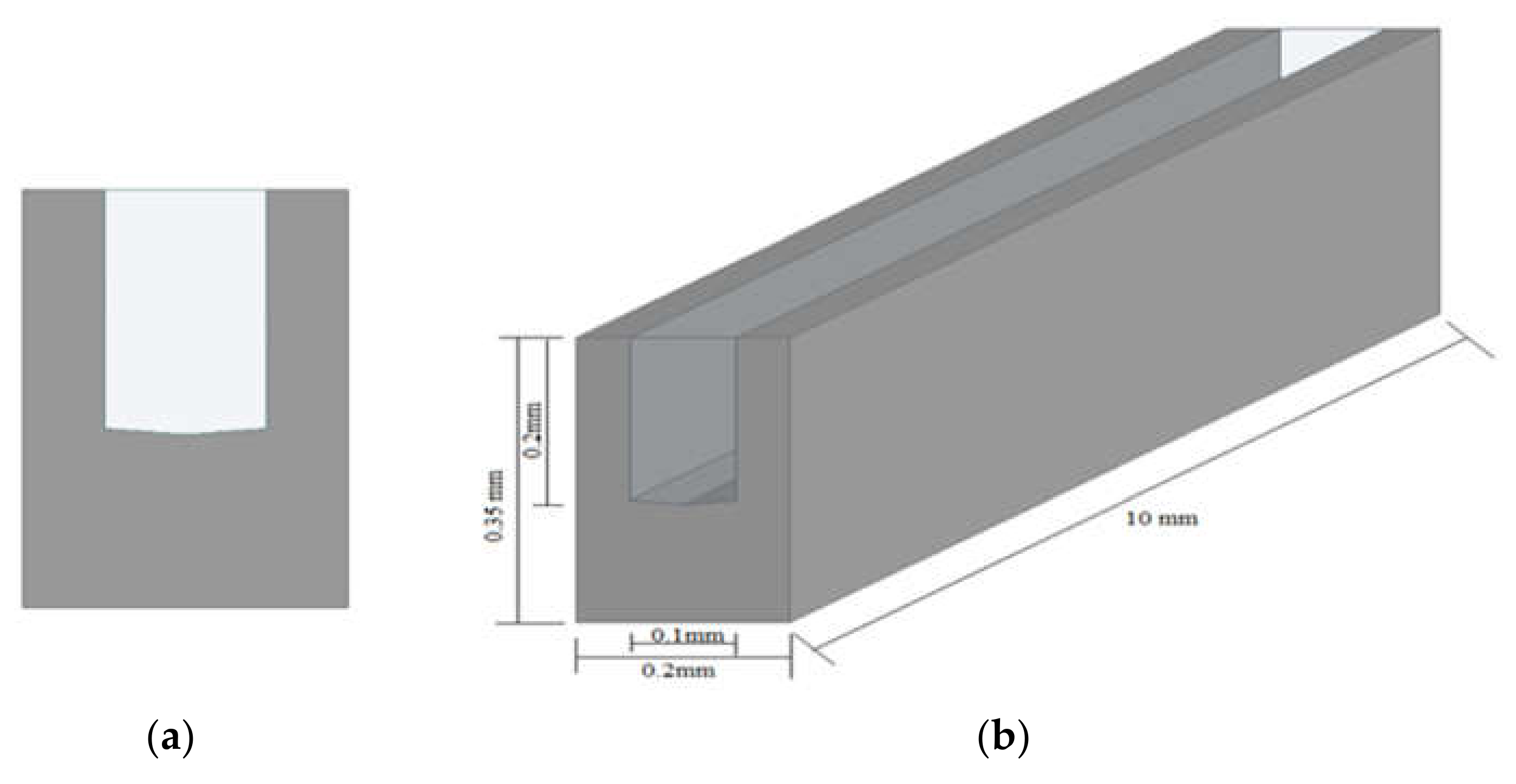
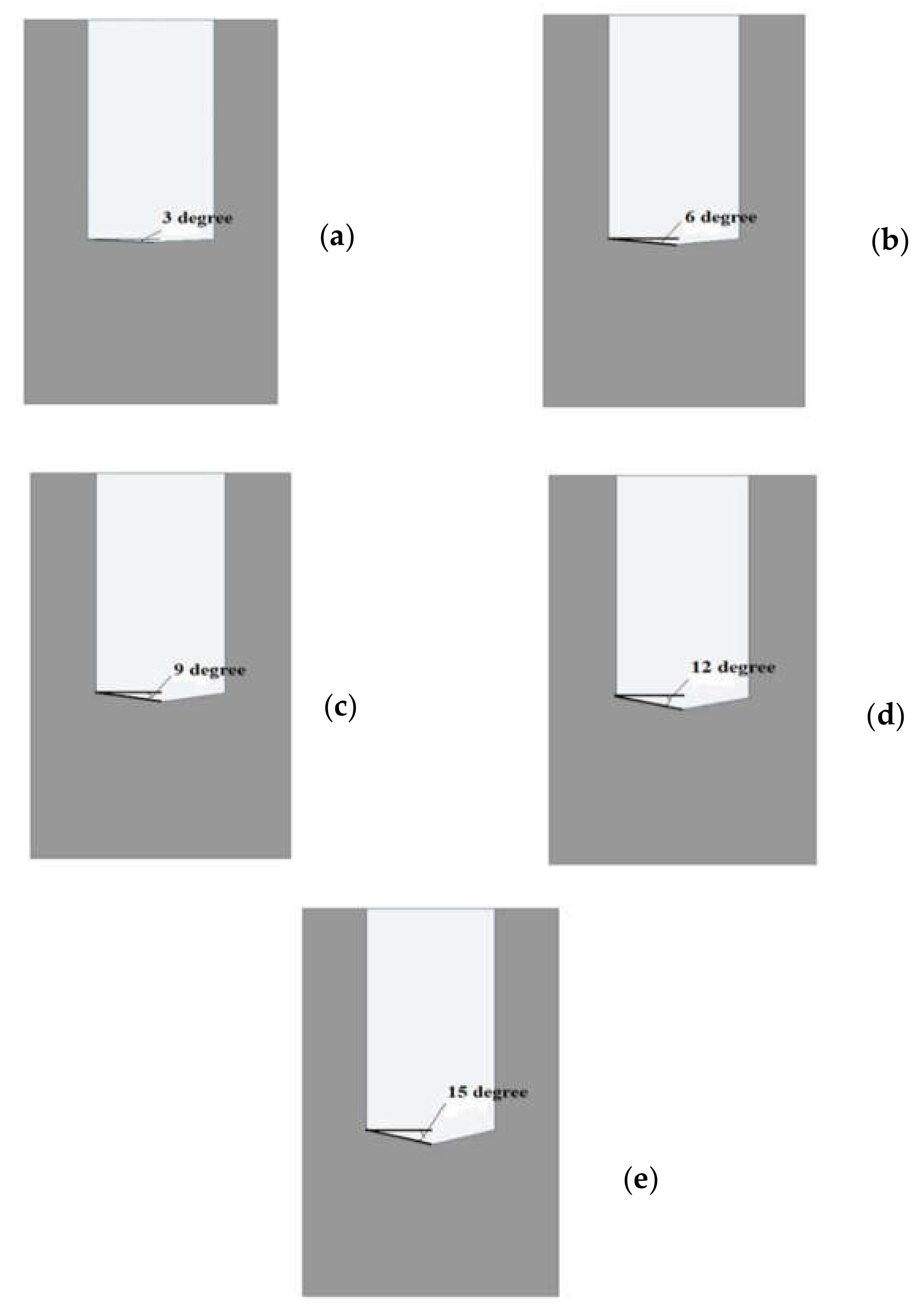



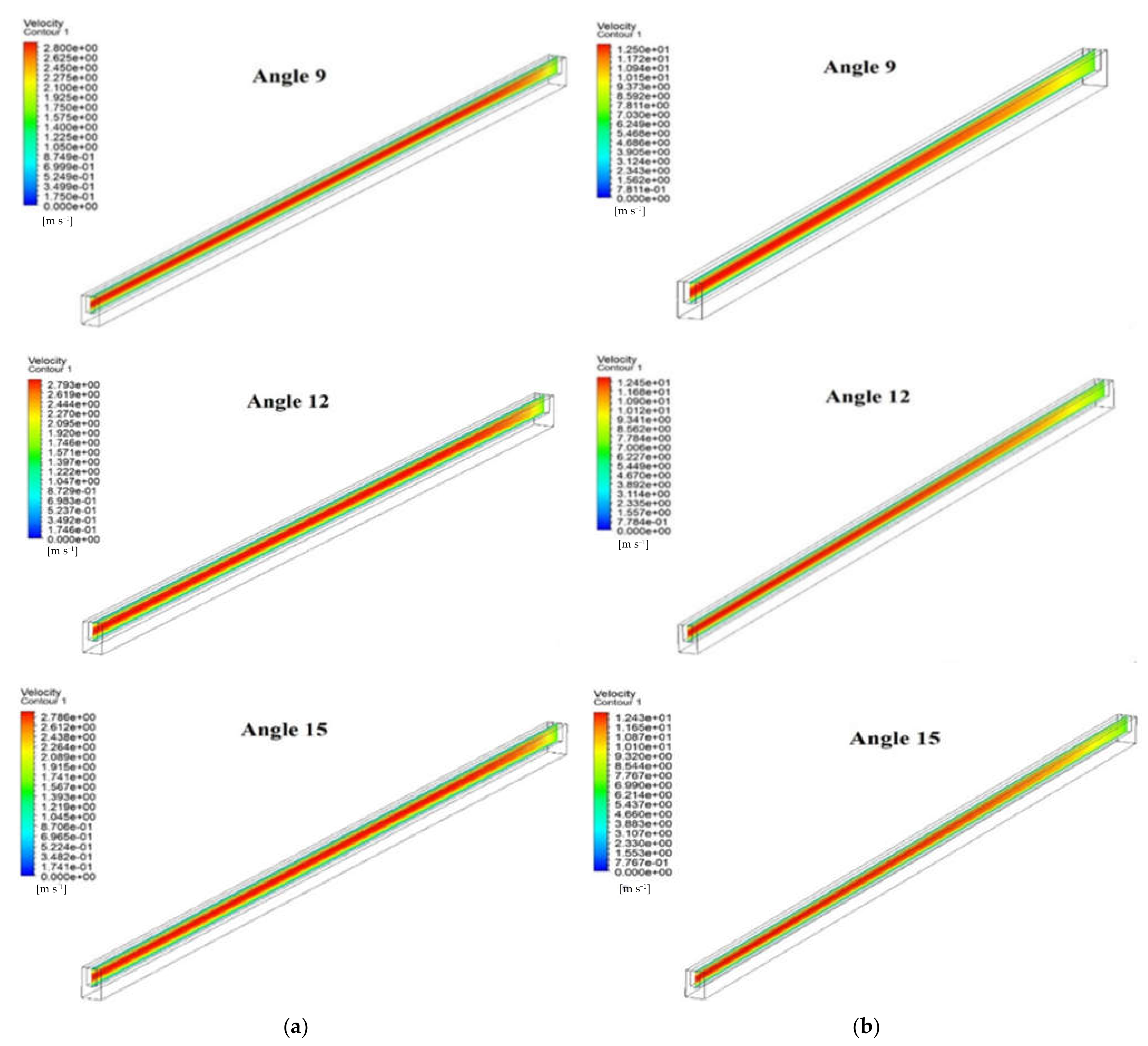
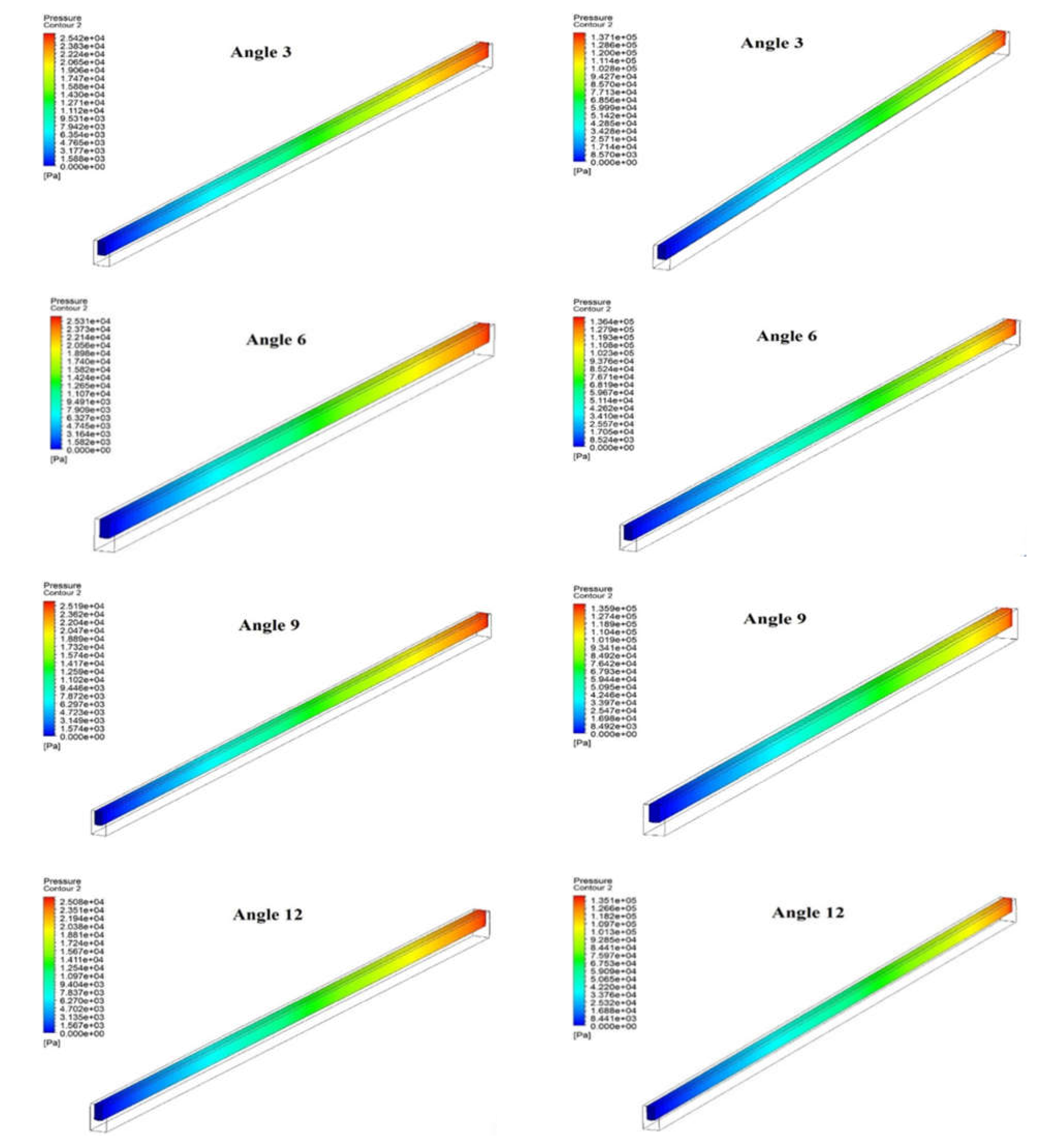

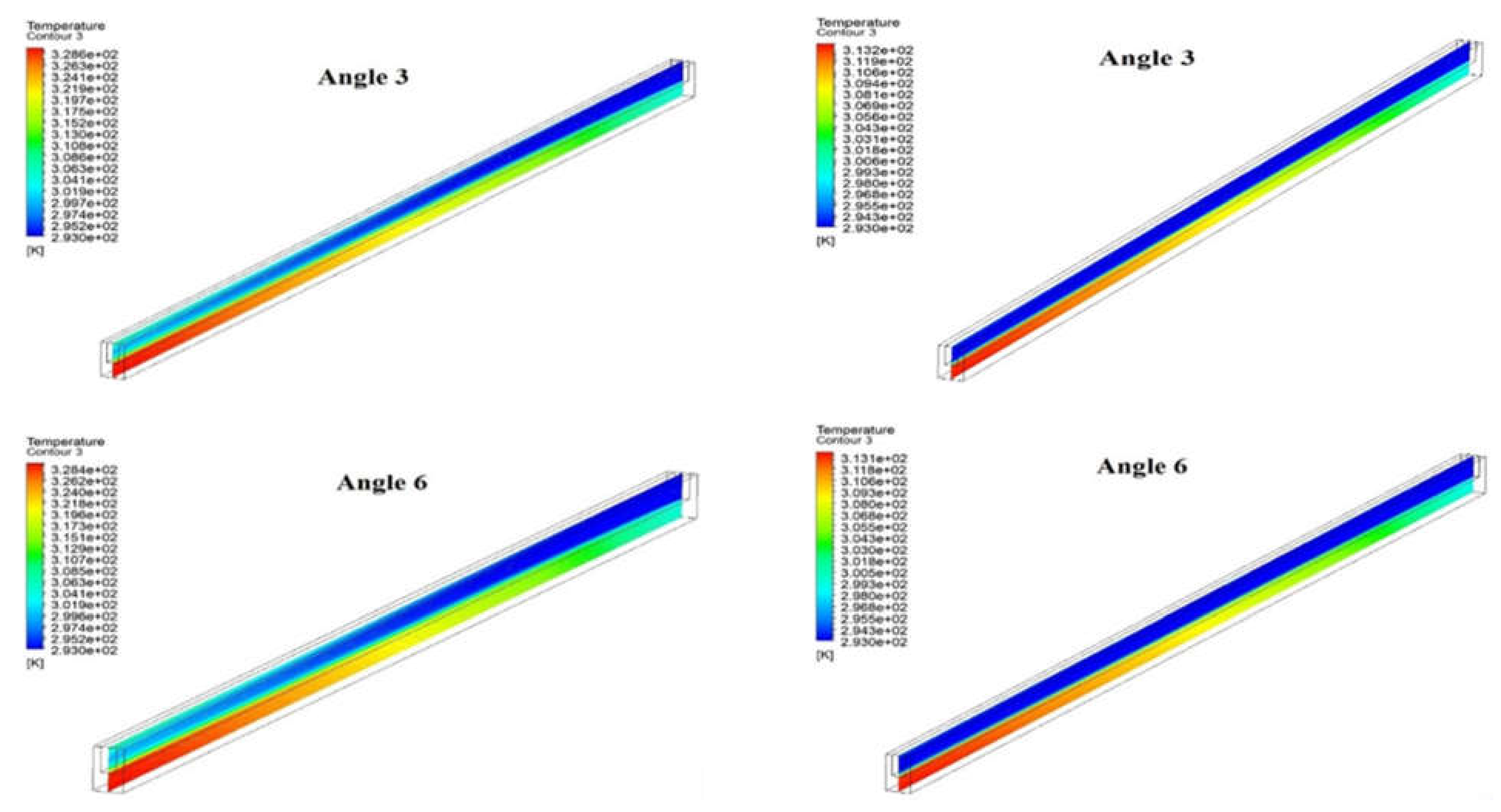
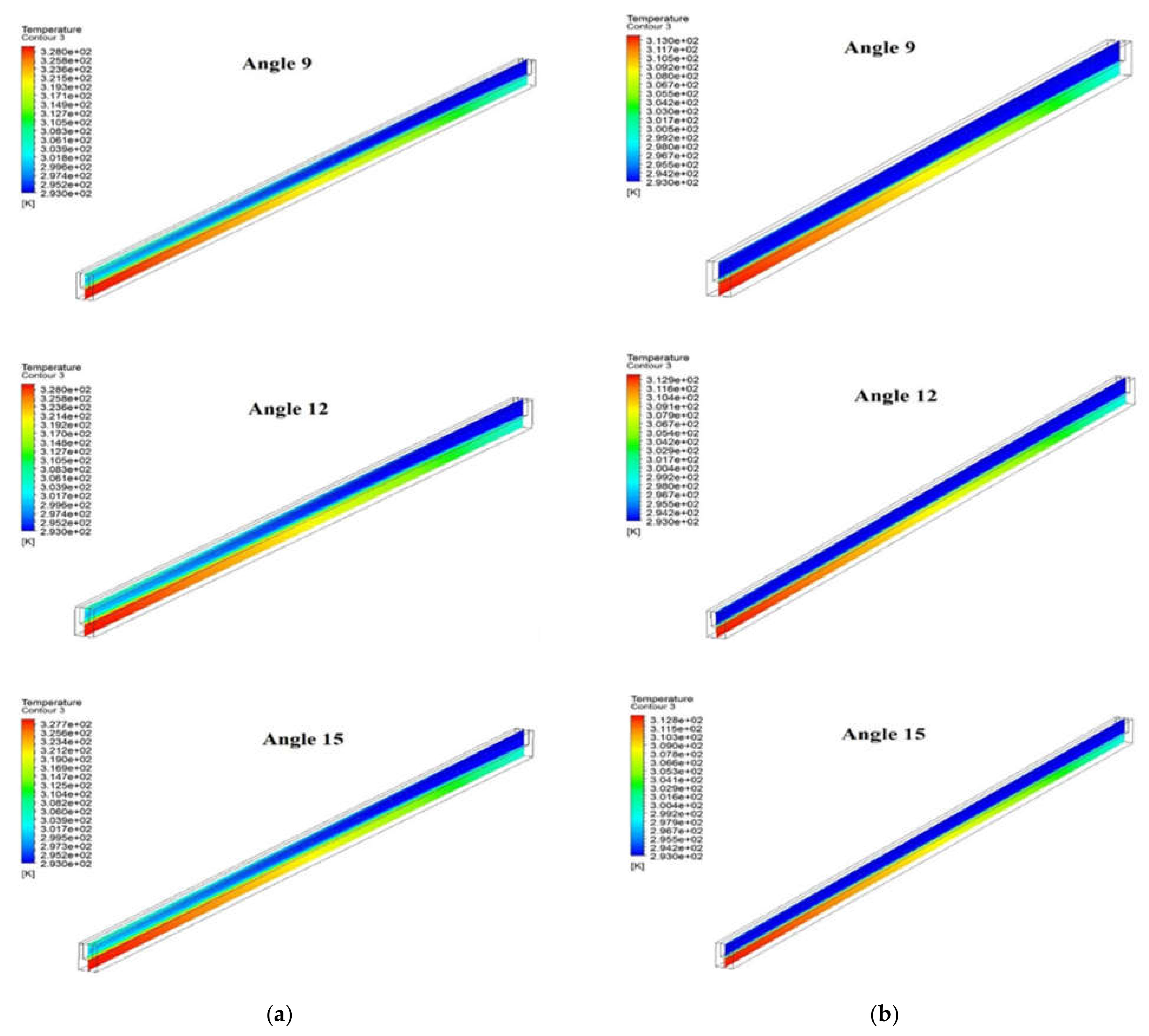
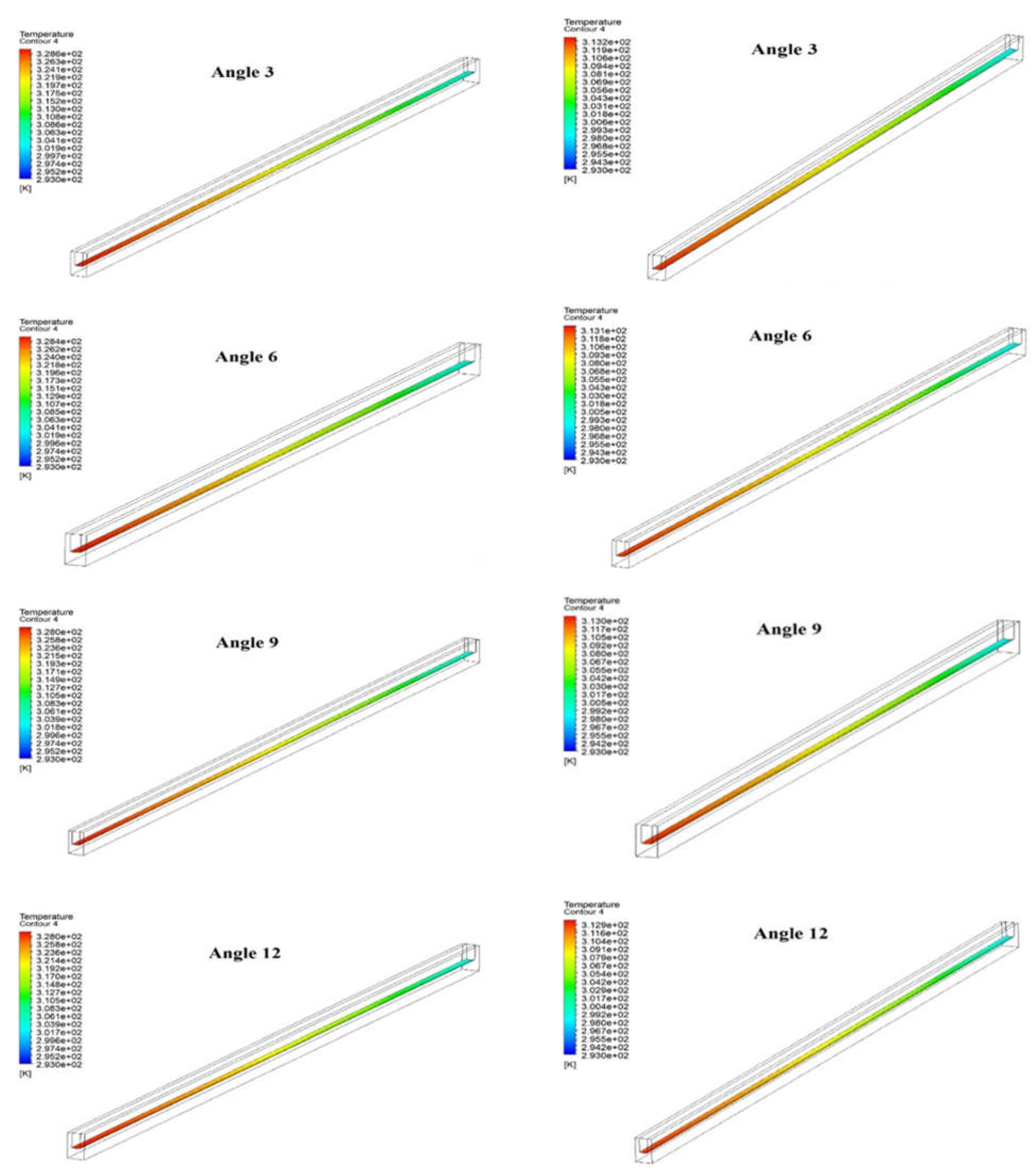


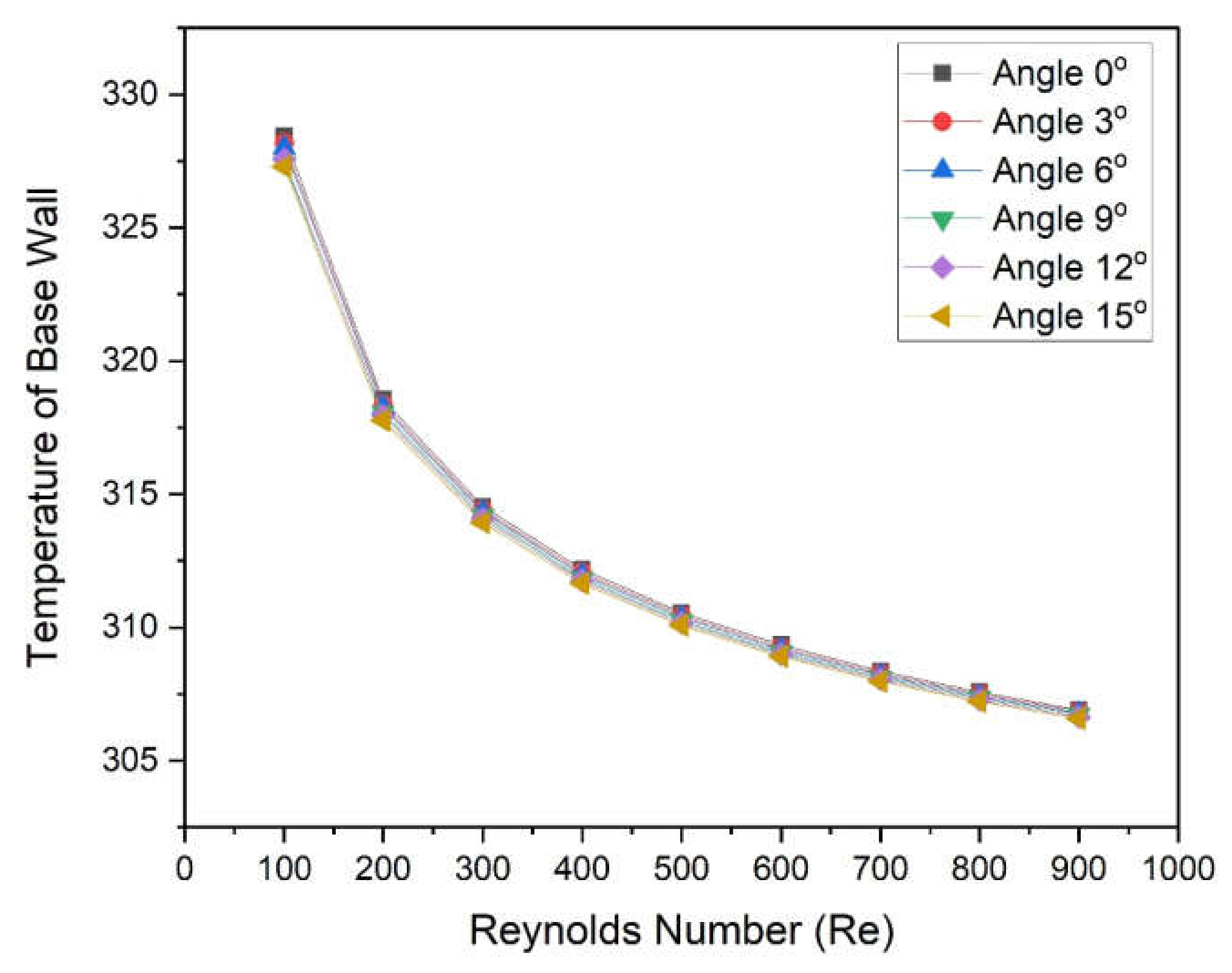
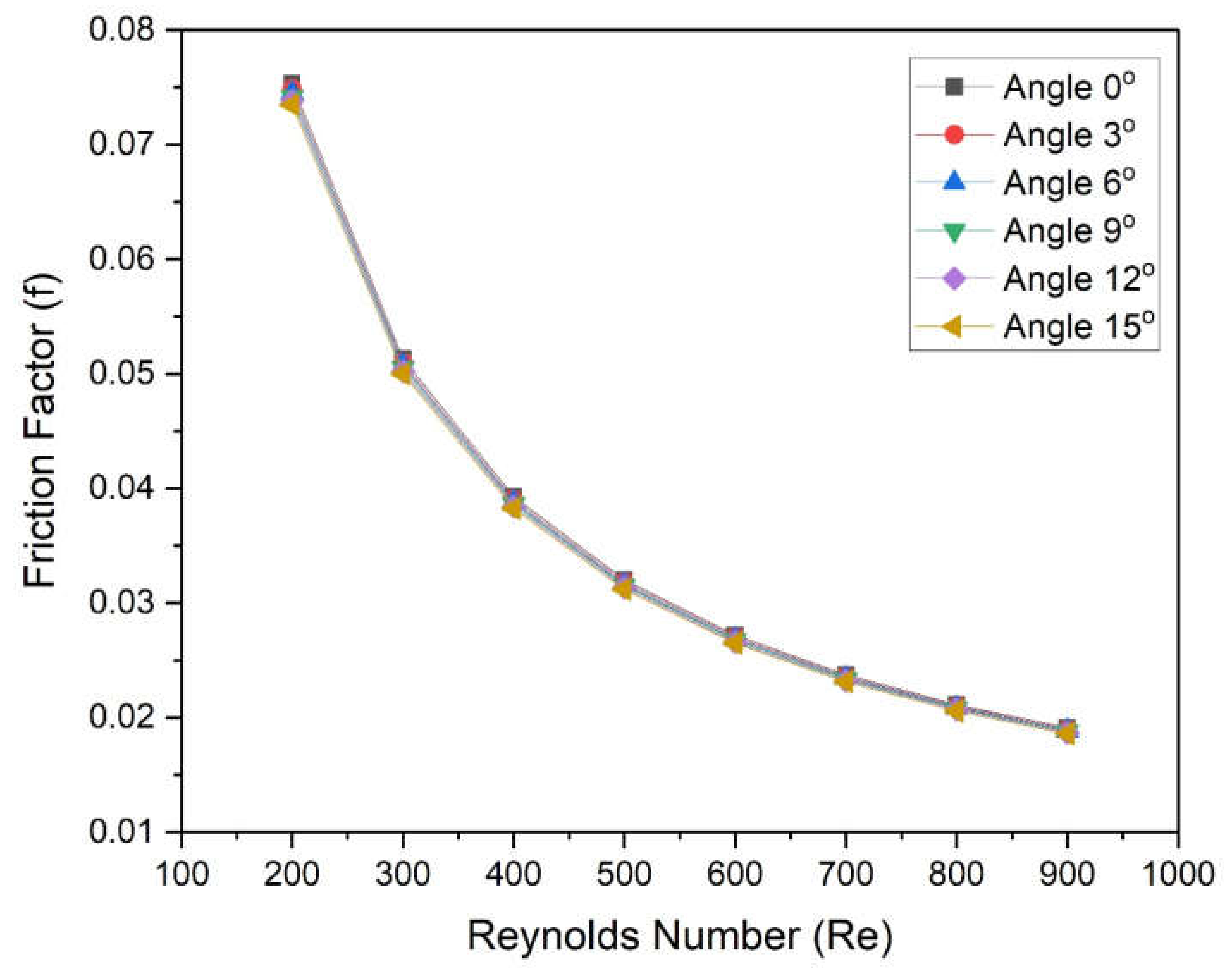

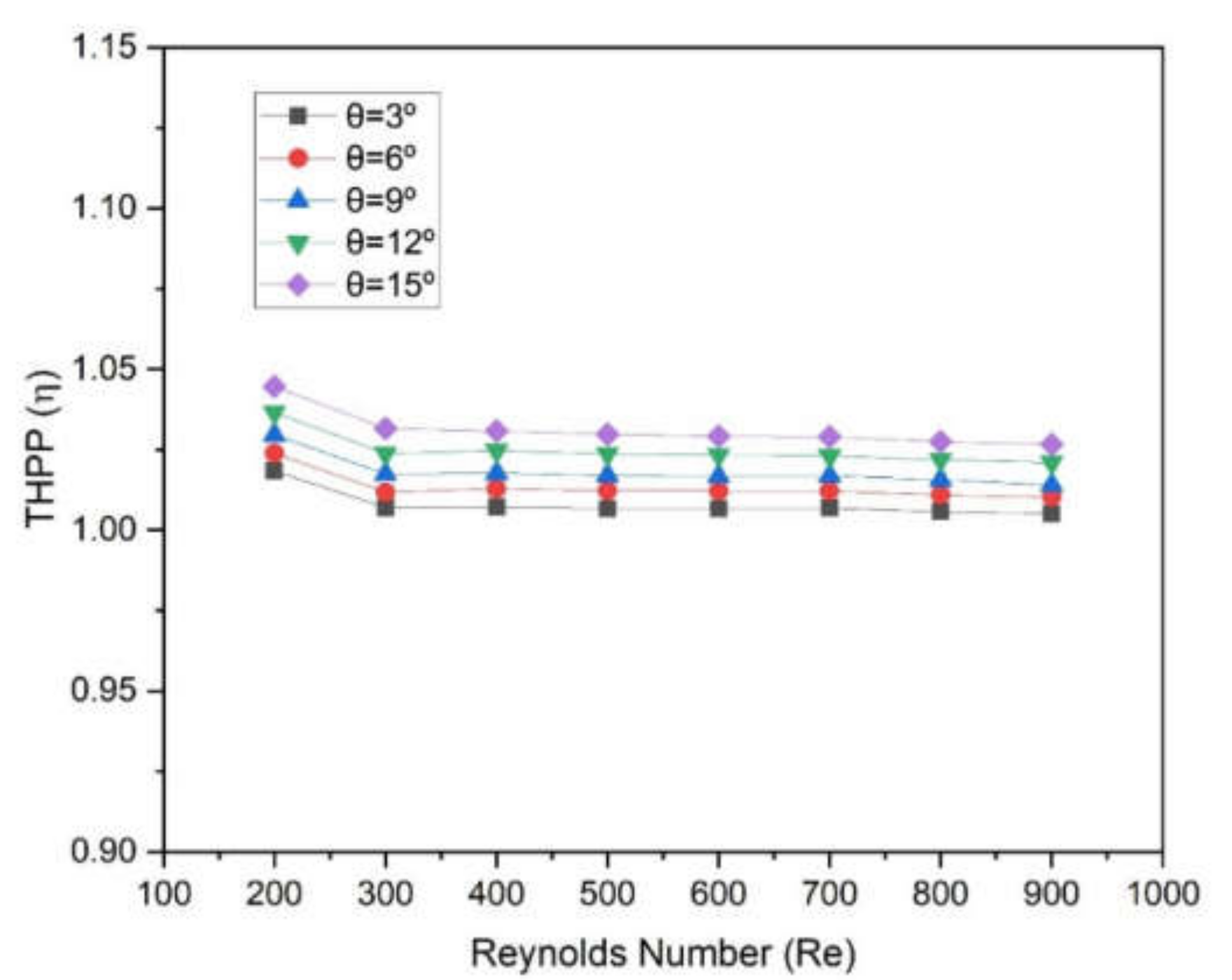
| Fluid | Density [kg/m3] | Dynamic Viscosity μ [Pa·s] | Thermal Conductivity k [W/m·K] | Specific Heat Cp [J/kg·K] |
|---|---|---|---|---|
| Water | 998.2 | 0.001 | 0.60 | 4182 |
| Material | Density ρs [kg/m3] | Thermal Conductivity ks [W/m·K] | Specific Heat Cps [J/kg·K] | Young’s Modulus Es [Pa] | Thermal Expansion ℘ [1/K] | Poisson’s Ratio α |
|---|---|---|---|---|---|---|
| Silicon | 2329 | 130 | 700 | 170 | 2.6 × 10−6 | 0.28 |
| S.No. | Nodes | Element | Microchannel Temp Tm (°K) | Percentage Variation in Tm (%) |
|---|---|---|---|---|
| 1 | 155,373 | 143,200 | 327.79 | ----- |
| 2 | 322,203 | 304,000 | 327.91 | 0.037 |
| 4 | 865,104 | 833,200 | 327.97 | 0.018 |
| 4 | 1,299,666 | 1,260,000 | 328.01 | 0.012 |
Publisher’s Note: MDPI stays neutral with regard to jurisdictional claims in published maps and institutional affiliations. |
© 2022 by the authors. Licensee MDPI, Basel, Switzerland. This article is an open access article distributed under the terms and conditions of the Creative Commons Attribution (CC BY) license (https://creativecommons.org/licenses/by/4.0/).
Share and Cite
Vatsa, A.; Alam, T.; Siddiqui, M.I.H.; Ali, M.A.; Dobrotă, D. Performance of Microchannel Heat Sink Made of Silicon Material with the Two-Sided Wedge. Materials 2022, 15, 4740. https://doi.org/10.3390/ma15144740
Vatsa A, Alam T, Siddiqui MIH, Ali MA, Dobrotă D. Performance of Microchannel Heat Sink Made of Silicon Material with the Two-Sided Wedge. Materials. 2022; 15(14):4740. https://doi.org/10.3390/ma15144740
Chicago/Turabian StyleVatsa, Aditya, Tabish Alam, Md Irfanul Haque Siddiqui, Masood Ashraf Ali, and Dan Dobrotă. 2022. "Performance of Microchannel Heat Sink Made of Silicon Material with the Two-Sided Wedge" Materials 15, no. 14: 4740. https://doi.org/10.3390/ma15144740








